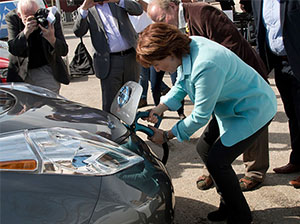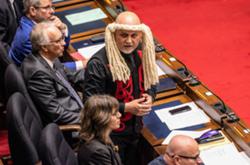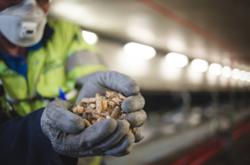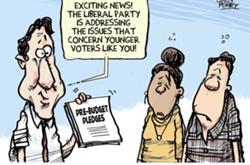
In March, the British Columbia government announced it will no longer pay a subsidy for any electric or hybrid vehicle that costs more than $77,000, but it made the change only after helping to pay for hundreds of high-end rides since 2011, including one that sells for over $1 million.
"I don't think the public wants us subsidizing anyone who can afford to buy a $100,000 vehicle," said Bill Bennett, who as the minister of energy and mines has responsibility for the program.
Yet for five years up until this February the province did just that, spending millions to provide up to $5,000 to lower the cost of luxury vehicles made by Tesla, Porsche and BMW.
Nearly one out of three of the 2,390 vehicles bought with help from the program before February 2016 would no longer qualify for the government-funded rebate, according to The Tyee's analysis of a table Bennett's ministry provided.
One person bought a plug-in hybrid Porsche 918 Spyder with the government's help. The pricey high performance sports car, hand-assembled in Germany, reportedly retails for $1.1 million in Canada and is promoted as having the same fuel consumption as a compact car.
The Spyder was the most expensive car for which the province provided a subsidy, and just one of more than 760 luxury vehicles receiving a government subsidy.
They included 648 of the Tesla Model S, an all-electric vehicle that starts at $87,300, and 21 of Tesla's Model X, which has a price tag of $130,000. There were also 54 of the BMW i8 ($145,000), 30 Porsche Cayennes ($87,700) and 10 Porsche Panameras ($110,000).
Altogether, the province paid about $3.8 million to help people buy vehicles that would now be deemed too expensive to receive the subsidy.
'Sickening,' says taxpayer federation
Minister Bennett said applying the subsidy widely made sense in the program's first two stages. "We weren't sure how well it would go, how popular the program would be with the public, so we put it across the board," he said.
"The second phase is where you saw vehicles go out the door very fast," he said, adding that both the government and the automobile dealers were surprised by the uptake. "That was a sign to us that we can probably make the subsidy apply somewhat more narrowly than the first two phases, so that's what we did. It's a reasonable change I think."
Bennett said the $77,000 figure was chosen so that the threshold would be the same as it is for the province's luxury vehicle tax.
The updated list of eligible vehicles includes ones from Audi, BMW, Cadillac, Chevrolet, Ford, Hyundai, Kia, Mitsubishi, Nissan, Smart, Toyota and Volvo.
"You'd have hoped they had more common sense at the start of this," said Jordan Bateman, the B.C. director for the Canadian Taxpayers Federation. "It's sickening to think somebody who's buying a million dollar car gets any money from taxpayers for that."
Creating a cap is better than not having one, said Bateman, who then questioned whether the program is needed at all. "Even despite these subsidies, the market isn't terribly interested in them," he said. "It's not government's job to build markets.... Government should scrap this program all together."
Even $77,000 is a lot for a car and anyone who can afford that probably could do so without $5,000 from the government, he said.
Referring to the chair of the Vancouver School Board, which is struggling to balance its budget, Bateman said, "I'm sure Patti Bacchus would have a suggestion on how to spend that money."
Cost coming down, says Weaver
Green Party MLA Andrew Weaver said introducing the cap was the right thing to do. "I'm glad they have a limit now," he said. "If you have $120,000 to buy a Tesla or a Porsche Spyder, you don't need a $5,000 tax break incentive."
Weaver himself recently bought a Nissan Leaf, a fully electric vehicle, which he said cost $28,000 after incentives from the dealer and the government were included. "I could have afforded about that for a new vehicle, or otherwise I'd be going second hand," he said. "So in my case the incentive is the reason why I did it."
The idea is for the subsidy to help average vehicle buyers make choices that are better for the environment, he said. "It made a difference for me. I think it would make a difference for most middle-class people. It would just be that nudge."
The Tyee recently reported that Jim Johnson, a resource economist who is the managing principle at the Victoria consulting firm Pacific Analytics, said the subsidy program is a very expensive way to reduce greenhouse gas emissions.
Meeting the goal of getting 200,000 electric vehicles on the province's roads would cost at least $1 billion in subsidies, or about $750 per ton of greenhouse gas emissions avoided. "That's a huge number," he said.
"It is at present a ton of money per ton," said Weaver, who is a climate scientist. However, through the subsidy the government is helping the early adopters, which will eventually lead to lower prices as electric vehicles become more common, he said.
Already the prices for electric vehicles are coming down to the point where it makes less sense to buy a car that requires gas, Weaver said. "There's going to come a time within a few years that we don't need incentives."
Incentives good, transit better, says NDP
Minister Bennett agreed it was unclear whether subsidizing the purchase of clean energy vehicles is the most cost-effective way to reduce greenhouse gas emissions. "I think the jury is out in terms of the return on investment, the $5,000," he said.
"On the other hand, getting those zero emissions vehicles on the road makes a meaningful difference and if we could get the proportion up over the next five years it actually has the potential to be very, very meaningful."
He added, "There's always more than the cost benefit analysis when you're trying to change people's habits. To get people driving electric cars, zero emission vehicles, means you have to change people's attitudes, and changing attitudes can be expensive and challenging."
The minister said his own attitude has changed. Being from Cranbrook, five years ago he wouldn't have considered a zero-emission vehicle, but now he plans to buy one soon, he said. They are a bit more expensive, but make sense with the subsidy, he said.
The NDP's environment critic, George Heyman, said that he supports providing incentives to help people buy electric vehicles, but that the government needs to do much more to reduce greenhouse gas emissions.
"Investment in transit would give a much better bang for the buck," he said, giving the example of the need for more rapid transit and bus service in the Lower Mainland. "They've done everything in their power to block every suggestion the mayors have put forward."
Compared to better funding transit, subsidizing the purchase of electric vehicles will help relatively few people, Heyman said.
"The electric vehicle announcements are important, but they're flashy," he said. "The Liberals are failing on those fronts that would have much greater impact on reducing greenhouse gas emissions in B.C., as well as helping a greater number of people." ![]()
Read more: Transportation, BC Politics, Environment
















Tyee Commenting Guidelines
Comments that violate guidelines risk being deleted, and violations may result in a temporary or permanent user ban. Maintain the spirit of good conversation to stay in the discussion.
*Please note The Tyee is not a forum for spreading misinformation about COVID-19, denying its existence or minimizing its risk to public health.
Do:
Do not: